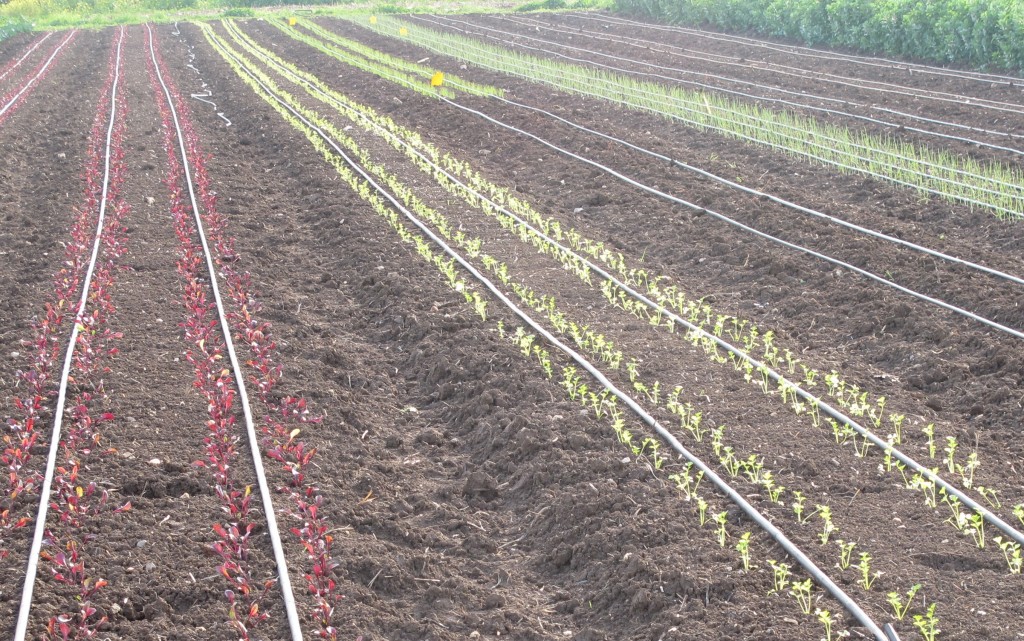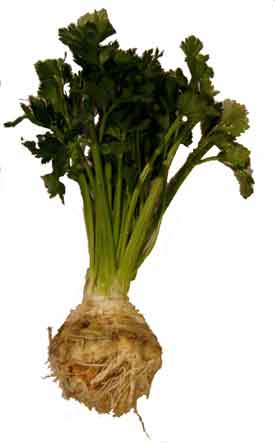This week we bid farewell to 2018 and welcome 2019 with open arms. This year, the transition takes place as rain is wondrously pouring down upon thirsty soil that well recalls its absence over the past winters. We too, working the earth, remember how our hearts sunk as our craving for rain soared. Now, along with our fields, we take a deep breath and relax as raindrops tap the most beautiful tune in the world on the roof of our packinghouse.
Our winter veggies are having a ball in the good rain, evidenced by their somewhat muddy arrival at your doorstep. For this week’s Newsletter, I will share the great secrets of an enduring winter guest who adores wet weather so much that it actually makes him plump around the edges… Ladies and gents, I’m pleased to introduce the star of the week… celery!
Its name carries the exotic origins of the French “céleri,” derived from the Greek “Selinon,” of the Apiaceae family. Celery is distinguished by the fact that all of this versatile vegetable’s parts are edible: the round root, its crunchy stalk, the nutritious leaves and its teensy, tiny seeds. Today, we will primarily discuss the leaves.
All celery varieties have tiny, miniscule seeds that take their sweet time sprouting. If you ever attempt to seed them in your garden, do not despair! Make sure they are plenty moist and that you have a very long book to read while you wait patiently for some sign of life. Mr. Celery is even slower than his cousin the parsley, taking at least a month till he feels he’s ready to sprout. We cannot wait so long with the seeds under the earth, specifically since ruthless weeds are liable to cover the bed five times before allowing one little celery shoot to peek above earth. This is why we start with actual plants that have already grown in a nursery, at the prime age of two to three months.
And here they are, the young ‘uns in our field (to their left, the red lettuce; to their right, the scallions)

Although celery is a native of the Mediterranean Basin, it has been carried upon the wings of history to reach almost every place on earth. Today the vegetable can be found in Southern Sweden, the British Isles, Egypt, Algeria, India, China, New Zealand, California, and even unto the southernmost parts of South America. Celery has a long history as a wild plant, and a relatively short one as a cultivated specie.
Celery is first documented in literature dating back almost 3000 years (making it evident that celery has been around for even longer). It is first noted by its Greek name Selinon in Homer’s Odyssey, circa 850 BC. Probably the ancient celery was collected from the wild to be raised in private gardens for a variety of medicinal uses (see below), but not for edible consumption. In the Mishnah, Tractate Shvi’it, it is mentioned as a wild plant (and therefore does not require a tithe) “… and the celery in the rivers… exempt from tithe.”
Only in the 17th century did celery begin to be used as a food and spice. It was cultivated by selecting the full and solid plants (not the hollow variety) with a milder, more subtle taste. The celery’s growing season was carefully chosen in order to produce celery leaves and stalks more suitable for consumption, with a less dominant taste. Growing celery during a cold season refines its taste. In the 19th century, the Europeans tried tempering its flavor by shielding the stalks from the sun, thus preventing the development of chlorophyll. To do so, they would mound earth upon the celery, thus whitening it (sort of like whitening a leek or white asparagus). Today there are species which are independently whitened and produce yellowish celery, however, modern green celery is, in fact, mild-tasting.
There are actually three subspecies of the celery, each grown to take advantage of a different part of the plant: The subspecies dulce is celery grown for its crunchy stalks, and is the most refined in flavor. The second, rapaceum, is grown for its root, making its stalks and leaves sharper tasting and more suitable for seasoning. And last comes the secalinum, resembling the wild species and grown in order to produce the strong, spicy-flavored miniscule celery seeds. This variety is also grown for its leaves, which – together with the seeds – are the most nutritious, useful parts of the celery with the greatest amounts of concentrates. Hence their strong flavor.
Back when it was a wild plant, celery was sanctified in classical Greece. Celery leaves were used as wreaths for the champions of the Isthmian Games. The Egyptians, too, revered the vegetable, as evident in braided bunches of celery that have been found in Egyptian tombs. The Romans, however, felt that in certain circumstances, celery can bring bad luck.
And yes, all those beliefs are well-rooted (sorry…..), as this vegetable is indeed a powerful one. It contains phytochemicals (yup, them again) called phthalid which can relax the small blood vessels, reducing the excretion of stress hormones and therefore contributing to the balance of high blood pressure. In addition, celery reduces the level of cholesterol in the blood. Research shows that celery seeds are helpful in reducing blood sugar levels and may be useful in treating diabetes. This is probably due to celery’s ethereal oil content, apiol, derived from the seeds and promoting urination, thus relieving edema, disinfecting the urinary system and easing rheumatoid arthritis. Celery also contains a good amount of Vitamin K, folic acid and potassium.
There are those who are allergic to the psoralen contained within celery, which can cause damage to DNA and become carcinogenic if one is exposed to sunshine after consuming the celery. This allergen is probably not diminished by cooking or baking. And though I found contradictory opinions regarding celery consumption during pregnancy– including the Talmud which states that a woman who eats celery during pregnancy will bear beautiful children (Ktuvot 61) – I think it would be more responsible to refrain from eating celery during pregnancy due to its tendency to cause uterine spasms.
I would guess that most of the celery stalks in our world fulfill themselves and their true calling in vegetable soup, and that’s how I used to use it as well… That is, till I moved to a moshav populated by folks of Kurdish origin, where I was exposed to the Riza Hamusta, the sour Kurdish rice. Since then, it has been hard to convince me to save some celery for the soup… But there are so many other uses for it. Celery’s great when fresh and crunchy in a salad or in an invigorating, cleansing vegetable juice. Be creative! In our recipe section we even have a recipe for celery pesto.
Tips for using celery:
To keep celery fresh (this holds true for any bunch of seasoning herbs):
– Wash and dry completely, or don’t wash at all. Wrap in a cloth towel and place in a plastic bag or sealed container.
– Clean under running water, remove all loose leaves or unattractive stalks, and place in a large vase with lots of cold water. Within a couple of hours, the stalk will look like a beautiful bloom. This way you will be surrounded by freshness, and you’ll remember to use the celery instead of letting it wilt in the refrigerator.
Wishing us all a great week. With this week forecast to be sunny and rainless, we give yet another thanks.
Alon, Bat Ami, Dror, Yochai, Orin and the Chubeza team
______________________________________
WHAT’S IN THIS WEEK’S BOXES?
Monday: Celery/celeriac/leeks, lettuce/mizuna/arugula, broccoli, beets/turnips, cucumbers, tomatoes, carrots, cauliflower, spinach/Swiss chard, radishes/baby radishes/daikon, kale.
Large box, in addition: Cabbage, coriander/dill/parsley, Jerusalem artichokes/potatoes/snow peas or garden peas.
FRUIT BOXES: Avocado, oranges, bananas, strawberries.
Wednesday: Celery/celeriac, lettuce, broccoli, beets, cucumbers, cauliflower/cabbage, tomatoes, carrots, spinach/Swiss chard/kale, radishes/baby radishes//turnips, coriander/dill/parsley.
Large box, in addition: Jerusalem artichokes/snow peas or garden peas, potatoes, leeks.
FRUIT BOXES: Avocado, oranges, bananas, apples.



